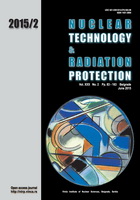
ELECTRONIC STRUCTURE AND CHEMICAL BOND NATURE IN Cs2PuO2Cl4
Pages: 99-112
Authors: Yury A. Teterin, Konstantin I. Maslakov, Mikhail V. Ryzhkov, Anton Yu. Teterin, Kirill E. Ivanov, Stepan N. Kalmykov, Vladimir G. Petrov, and Dmitry N. Suglobov
Abstract
X-ray photoelectron spectral analysis of dicaesiumtetrachlorodioxoplutonate (Cs2PuO2Cl4) single crystal was done in the binding energy range 0-~35 eV on the basis of binding energies and structure of the core electronic shells (~35 eV-1250 eV), as well as the relativistic discrete variation calculation results for the PuO2Cl42- (D4h). This cluster reflects Pu close environment in Cs2PuO2Cl4 containing the plutonyl group PuO22+. The many-body effects due to the presence of cesium and chlorine were shown to contribute to the outer valence (0-~15 eV binding energy) spectral structure much less than to the inner valence (~15 eV- ~35 eV binding energy) one. The filled Pu 5f electronic states were theoretically calculated and experimentally confirmed to present in the valence band of Cs2PuO2Cl4. It corroborates the suggestion on the direct participation of the Pu 5f electrons in the chemical bond. The Pu 6p atomic orbitals were shown to participate in formation of both the inner and the outer valence molecular orbitals (bands), while the filled Pu 6p and O 2s, Cl 3s electronic shells were found to take the largest part in formation of the inner valence molecular orbitals. The composition of molecular orbitals and the sequence order in the binding energy range 0-~35 eV in Cs2PuO2Cl4 were established. The quantitative scheme of molecular orbitals for Cs2PuO2Cl4 in the binding energy range
0-~15 eV was built on the basis of the experimental and theoretical data. It is fundamental for both understanding the chemical bond nature in Cs2PuO2Cl4 and the interpretation of other X-ray spectra of Cs2PuO2Cl4. The contributions to the chemical binding for the PuO2Cl42- cluster were evaluated to be: the contribution of the outer valence molecular orbitals –66 %, the contribution of the inner valence molecular orbitals –34 %.
Key words: X-ray photoelectron spectroscopy, valence molecular orbitals, plutonyl group
FULL PAPER IN PDF FORMAT (2.06 MB)
